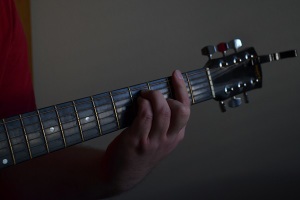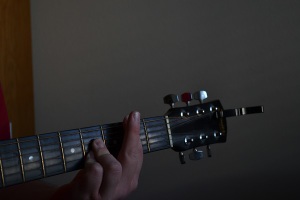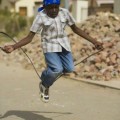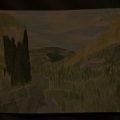Welcome to finger abuse, part 2. These techniques, while occasionally painful, are highly useful for playing certain songs, and will help you understand some of what you hear.
Go to Part 1 of this series on learning to play the guitar.
Bar chords
Before we get to the chords themselves, a little musical theory is necessary. While there are eight note names (A B C D E F G), there are twelve tones in total. This is where sharps and flats come into play. For instance, between A and B there is A#. Keep in mind, though, that A# is the same as Bb. The full list goes like this:
A A#/Bb B C C#/Db D D#/Eb E F F#/Gb G G#/Ab
Notice that B and E don’t get a sharp, and that C and F don’t get a flat. That is because, while there are usually two half steps between each whole note, there is only one half step between B and C, and E and F.
The point of all this is, each fret on your guitar is a half step. When you make a bar chord, you hold down all the strings with your pointer finger, then hold down the chord shape with your other fingers. For instance, if you hold down your pointer finger on the second fret and make an A chord with your other fingers, that makes the B chord (A plus two half steps makes B). You can do the same thing with the E chord shape, as well as the C chord, though the C chord is a little harder.
A tip when doing A-shaped bar chords: Rather than trying to get all three fingers onto the strings, try pressing your ring finger across multiple strings. You may find that you tend to mute the e string accidentally; if so, use your ring finger on the top two of the A chord and your pinkie for the last one.
It may seem like a lot of work at first, but keep practicing. Bar chords are nice in that you can change chords quickly just by moving the shape up and down the frets. For this reason, and for the unique sound they make, you will find a lot of guitarists use bar chords when writing songs.
Picking patterns and base notes
Now that you have a good grounding in chords, it’s time to make use of it. Strumming is all well and good, but picking patterns lends a sense of complexity and melodic movement. A picking pattern is a pattern for plucking strings in relation to a chord. Most of them start with the base note of the chord, which is usually on the E or A strings. Here are the base notes of each chord:
A B C D E F G
e—————————————–
B—————————————–
G—————————————–
D——————0——–(3)————–
A–0—2—-3——————————-
E————————0—-1—3———
Notice how F seems to have two base notes? That’s because the chord shape I taught you in part 1 is actually an abbreviated form of the F bar chord. Now, while you can use your thumb to strike each string, it is better (and faster) to use your other fingers, and use your thumb to strike the base notes. Here are two picking patterns to try out, using the E, Am, and D chords:
e————–0————————0————————2———-
B———0——–0—————1——1—————–3——3——
G—–1—————1——–2————–2——–2—————2–
D—————————————————–0———————–
A————————–0————————————————–
E–0————————————————————————–
e–0—————0——————-2——–2————————————
B———0——————1———————–3——————————-
G————-1——————2———-2—————————————-
D—–2—————–2————-0———————————————-
A——————0——————————————————————-
E–0———————————————————————————–
Experiment with different chord progressions, different patterns, and so on, and you are well on your way to writing a song.
Bending, hammer-ons, pull-offs, and slides
These techniques are mostly used to play solos and riffs, but are good to know and play around with.
Bending is when you push the string down and to the side, and makes the pitch go higher. On acoustic guitars, you can generally bend a string one whole note higher, and it’s easier to do so further away from the head of the guitar. Electric guitar strings have a bit more give to them, and you can bend those about two whole notes higher. In tab notation, bending is signified like this:
e——-4b5——- and e——-8b10b8——
The number after the ‘b’ indicates the tone you are trying to bend to. Sometimes, you will get e—8b7—, which means start off bending the string to the eight tone, then pluck the string and bring it back down to the seven tone.
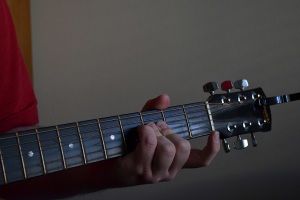 Hammer-ons and pull-offs are a pair of techniques you do once you have already plucked the string. With a hammer-on, you bring a finger down on the fret indicated, making it sound like the tone jumps to the new note. With a pull-off, you remove your finger from the fret, letting the lower note ring out. Sometimes simply removing your finger won’t affect the sound too much, in which case while you remove your finger, have that finger pluck the string.
Hammer-ons and pull-offs are a pair of techniques you do once you have already plucked the string. With a hammer-on, you bring a finger down on the fret indicated, making it sound like the tone jumps to the new note. With a pull-off, you remove your finger from the fret, letting the lower note ring out. Sometimes simply removing your finger won’t affect the sound too much, in which case while you remove your finger, have that finger pluck the string.
Hammer-ons are notated like this: e——2h3—— and pull-offs like this: e——4p3——
Sliding is related, where once the string is plucked, you keep your finger pressed down, but slide it up or down the fretboard to the indicated fret. It is notated thusly: e—–2/7—– and e——51—-
Don’t be discouraged if what I have discussed here is difficult for you, it took me a long time to build up the finger strength and patience to get these right. Just keep practicing, and play songs you like. You will gain a new appreciation for the hard work and creativity that musicians put into the songs they write. You may even be inspired to write and play your own songs, which can be very satisfying all by itself.
Keep playing, Dream Weavers!
About Brandon Quist
Brandon is originally from Olmsted Falls, Ohio. He has studied both at Baldwin Wallace college and Brigham Young University, and is currently pursuing Chemical Engineering, among other things. He considers himself a jack of all trades, and a master of none. In his spare time, Brandon enjoys knitting, guitar, reading, origami, writing, and photography.


